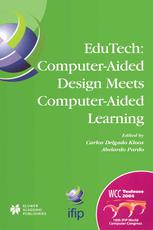

Most ebook files are in PDF format, so you can easily read them using various software such as Foxit Reader or directly on the Google Chrome browser.
Some ebook files are released by publishers in other formats such as .awz, .mobi, .epub, .fb2, etc. You may need to install specific software to read these formats on mobile/PC, such as Calibre.
Please read the tutorial at this link: https://ebookbell.com/faq
We offer FREE conversion to the popular formats you request; however, this may take some time. Therefore, right after payment, please email us, and we will try to provide the service as quickly as possible.
For some exceptional file formats or broken links (if any), please refrain from opening any disputes. Instead, email us first, and we will try to assist within a maximum of 6 hours.
EbookBell Team

5.0
58 reviewsEduTech: Computer-Aided Design Meets Computer-Aided Learning
Edited by Carlos Delgado Kloos and Abelardo Pardo
Computation and communication technologies underpin work and development in many different areas. Among them, Computer-Aided Design of electronic systems and eLearning technologies are two areas which, though different, in fact share many concerns. The design of CAD and eLearning systems already touches on a number of parallels, such as system interoperability, user interfaces, standardisation, XML-based formats, reusability aspects, etc. Furthermore, the teaching of Design Automation tools and methods is particularly amenable to a distant or blended learning setting, and implies the interconnection of typical CAD tools, such as simulators or synthesis tools, with eLearning tools. There are many other aspects in which synergy can be found when using eLearning technology for teaching and learning technology.
EduTech: Computer-Aided Design Meets Computer-Aided Learning contains the proceedings of the EduTech2004 workshop, which was held in August 2004 in conjunction with the 18th IFIP World Computer Congress in Toulouse, France, and sponsored by the International Federation for Information Processing (IFIP). Organized by IFIP WG 10.5 (Design and Engineering of Electronic Systems) in cooperation with IFIP WG 3.6 (Distance Education), the workshop proceedings explore the interrelationship between these two subjects, where computer-aided design meets computer-aided learning. The book includes papers related to eLearning in the area of electronic CAD, but also includes contributions tackling general issues of eLearning that are applicable to this and many other areas such as reusability, standards, open source tools or mobility.
This book will be of value to those interested in the latest developments in eLearning in general, and also to those coming from the electronic design field who want to know how to apply these developments in their area.